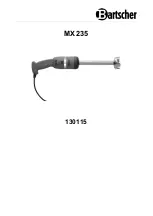
3
US
o
peratIon
of
the
mIxer
:
The bowl must be mounted when the
mixer is started!
a.
Turn the rotary knobs to the locking symbol
(fig. 3A)
.
B.
Tilt backwards the upper part of the mixer.
C.
Place a tool in the bayonet shaft and turn it counter-
clockwise to lock it in position
(fig. 4)
.
D.
Place the bowl between the three locking bolts in the foot
of the mixer and turn it clockwise until locked
(fig. 5)
.
e.
Fill the ingredients in the bowl.
F.
Tilt the upper part of the mixer, including tool, down.
g.
Start the mixer by turning the rotary knobs away from the
locking symbol and past
1
. To avoid splashing and dust
from flour, it is recommended to increase the speed gradu
-
ally until the required speed is obtained
(fig. 3C)
, (see
fig.
2
for recommended working speeds).
H.
Stop the mixer by turning the rotary knobs back to neutral
position
(fig. 3B)
.
i.
The upper part of the mixer can only be tilted backwards
when the rotary knobs is turned to the locking symbol
(fig. 3A)
.
m
axImUm
CapaCIty
of
the
mIxer
:
The working capacity of the mixer depends of:
•
The tool used.
•
Sort and quantity of the raw materials.
•
The optimum speed for a good result.
Too big quantities will always reduce the
quality of the product and the life of the mixer.
Overloading can also result in sudden stops.
o
verloadInG
:
If the mixer is moving e.g. kneading dough, this is
not
due to
errors or overloading.
In case of overloading the electronic variator will reduce the
current to the motor and stop it.
In case of stop due to overloading, turn
the rotary button back to neutral position,
and the mixer can be started again.
If the motor stops after long time of operation, and cannot be
started immediately after, the thermosensor of the motor has
switched off the current, and the mixer needs to cool down before
it can be re-started. This protects the motor from overheating.
The mixer contains two thermal cut-outs, which automatically
reconnect in case of previous disconnection by the thermo-
sensor.
C
leanInG
and
hyGIene
:
after use:
•
Remove bowl and tools.
•
Wash the bowl and the tools in hot water and detergent /
degreaser / disinfectant. Rinse with pure water and dry.
Do not spray water on the mixer
Tools and bowl can be cleaned in dish-
washer.
•
Wipe the housing of the planetary gear, the bayonet shaft
and the bowl screen. Use a damp sponge and a deter-
gent / disinfectant. Rinse the parts with sponge and pure
water.
•
Check that the various parts have been cleaned thor
-
oughly.
•
Do not use abrasive detergents, which could scratch the
surface.
•
Use detergents suited for use on aluminium and plastic
(polycarbonate).
a
: Locking symbol
B
: Neutral position
C
: Speeds
Fig. 4 Mounting of tool in the bayonet shaft.
Fig. 5 Place the bowl in the mixer and turn it to be fixed
in the locking bolts.
Locking bolts
Fig.3 The three positions of the rotary knobs.


























